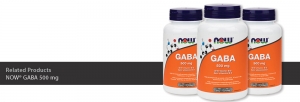

GABA for stress and sleep support
You may have noticed that γ-aminobutyric acid (GABA) is a popular supplement ingredient found either as a stand alone or in a formula for stress and/or sleep.
What is GABA?
GABA by definition is both an amino acid (although it is not involved in making proteins) and a neurotransmitter. Neurotransmitters are chemical messengers in our central nervous system (the brain and spinal cord) that have profound effects on our moods, our sleep-wake cycles and more. GABA stands out as our primary inhibitory neurotransmitter, and as such, it is associated with a state of calm and relaxation. When GABA goes up, we wind down. As GABA drops, we become more anxious and panicked. At extremes, very low GABA levels would enter us into a state of seizures. Studies suggest that major depressive disorders can been associated with “altered GABA-mediated response”.
GABA Drugs
Prescription medications with similar structures to GABA (GABA analogs) are used to treat a variety of disorders and diseases. While experts are not entirely sure how they work, the general consensus is that they bind to calcium-channels within the nerve cells, and that this either enhances our brain cells’ response to GABA, or makes the release of GABA more efficient. GABA-targeted prescription medications include those for epilepsy (anticonvulsants) as well as anxiety (anxiolytics) and sleep (sedative hypnotics). They are also sometimes used to treat fibromyalgia, nerve pain, alcohol addiction and restless leg syndrome. But there are downsides to these strong drugs that have not been associated with the natural supplements. GABA analogues can be addictive and cause withdrawal symptoms such as seizures, are associated with an increase in suicidal thoughts and behaviours, may put humans at increased risk of tumors (based on animal studies on Gabapentin), have been known to cause fatal multi-organ sensitivities, and more. Dizziness and drowsiness are the most common side effects experienced on these drugs.
The GABA Pathway
The GABA pathway in the central nervous system is particularly fascinating, because the precursor (what comes before) to GABA is glutamate. In contrast to GABA, glutamate is the brain’s most stimulating neurotransmitter! In fact, too much of it acts like a neurotoxin. Heard of the food flavouring enhancer Monosodium glutamate or MSG? This too is known to be potentially harmful in excess, because it stimulates our brain. So why would these two opposites follow one another? Perhaps it is to keep one another in check. Glutamate is like Yang in Chinese Medicine, fast and furious. GABA, is like Yin, calming and grounding. In order to convert glutamate to GABA the pathway requires magnesium and vitamin B6. This may in part explain why this mineral and vitamin alone can sometimes help with sleep or mood.
How do we get GABA?
GABA is a non-essential amino acid because it can by synthesized in the body from glutamine. We can also get GABA from our diet, especially from fermented foods like kimchi and aged cheeses. Green tea, as well as a handful of fruits, vegetables and grains, are also sources of GABA. Recently we have discovered that some species of bacteria in our gastrointestinal tract (in particular Bacteroides, Parabacteroides and Escherichia species) produce GABA through the same pathway as exists in our central nervous system. This GABA acts as a growth factor to help other bacteria thrive and is also correlated with brain patterns associated with depression.
How is GABA helpful?
Human studies suggest that an oral dose of GABA of 100 mg is associated with an increase in the ratio of alpha waves in the brain. Alpha waves are present during a relaxed state. Clinically, people find GABA helpful for states of stress and/or stress related insomnia. Available doses range from 100 mg to 750 mg. Since GABA’s effects seem to be short lived, some people prefer to take low doses repeatedly.
NOW® GABA Products
NOW® has a wide range of GABA products for consumers to pick from. The highest dose GABA comes in 750 mg of GABA, both instant and time release (lasting 4 hours). For those looking for greater impact, GABA also comes in highly effective, synergistic combination products such as NOW® True Calm, which includes three amino acids all acting on the same GABA pathway (GABA, Glycine and Taurine). NOW® True Calm also contains vitamins B6 and magnesium, which as stated earlier, are both important for the GABA pathway. Our NOW® GABA chewable with GABA, taurine, inositol and l-theanine (from green tea) is especially popular for its great flavour and ease of use.
Reference:
https://www.ncbi.nlm.nih.gov/pubmed/30531975

